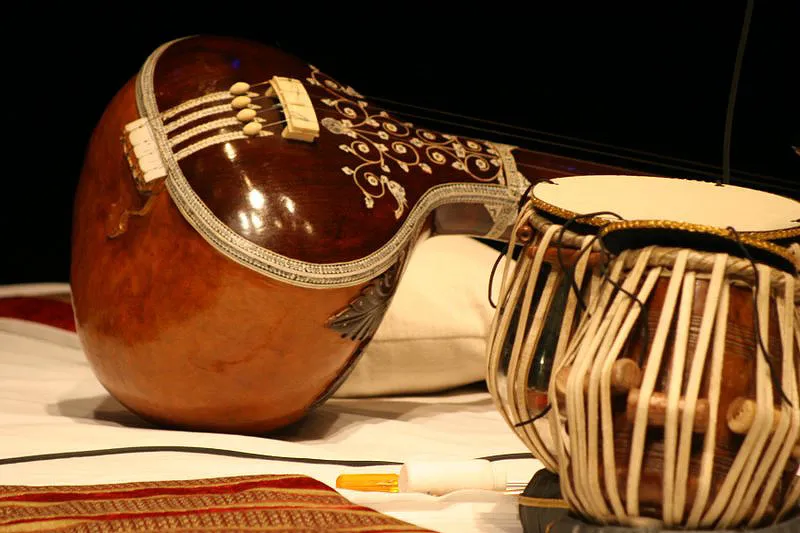TALA
Tala in Indian Classical music is a term referring to music meter, a measure of musical time or a rhythmic beat or clap. It can even mean verbally striking small cymbals or a percussion instrument. Tala, the time cycle along with raaga (melodic framework) is one of the two foundation elements of Indian music. While tala carries the musical meter, it does not necessarily have to follow a regular pattern. The beats are arranged hierarchically depending on how the piece of music which is to be performed.
ORIGIN OF TALA IN THE SAMAVEDA
Tala like Swara has also originated form the Samaveda. The Samaveda is divided into 2 parts. One is the musical meter and the other are the rituals. The Rigveda too shows the musical meter but in the Samaveda the musical meter is shown in much more details and more elaborately. The chants in the Vedas which are to be recited are presented in ‘matras’ or multiples in the ratio of 1:2:3. The Samaveda also included a system of hand signals (chironomy) to set the speed of the recitals. These are jatis (finger counting of beats. These jatis along with the mudras (finger and palm postures) form the basis of the Tala system.
A professor of music, Lewis Rowell, who specialized in Indian classical music believes that as there was a oral system of transmission of compositions and mantras, without any formally written text, it was this systematic structure and meters that helped memorizing and transmitting this knowledge from one generation to the next without errors.
The Vedic texts were orally composed and transmitted, without the use of script, in an unbroken line of transmission from teacher to student that was formalized early on. This ensured an impeccable textual transmission superior to the classical texts of other cultures; it is, in fact, something like a tape-recording.... Not just the actual words, but even the long-lost musical (tonal) accent (as in old Greek or in Japanese) has been preserved up to the present.
— Michael Witzel
TALA IN THE NATYA SHASTRA AND SANGITARATNAKARA
In the Natya Shastra, the text on the foundation of Indian classical music, “small brown cymbals” which were classified as solid instruments or idiophones, were used for tala. There is almost a entire chapter dedicated to idiophones by Bharata in the Natya Shastra. Time keeping with the idiophones was considered as a distinct function, separate from membranophones (percussion instruments).
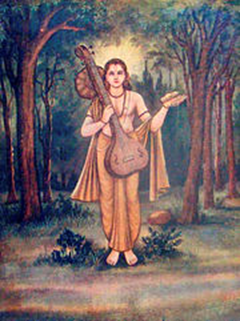
Above is a painting depicting the
Vedic sage-musician Narada holding
a tala instrument in his left hand
The Sangitaratnakara, an early 13th Century text by Sarnagadeva, also mentions and discusses Ragas and Tanas. In this text, the author identifies seven tala families and then subdivides them into rhythmic ratios and presents a method of improvisation that is used by Indian Classical singers even today
TALA IN INDIAN CLASSICAL MUSIC
Tala refers to the regular rhythmic pattern or phrase of equally placed beats of any composition. Each tala or pattern has its own unique name which denotes how many beats there are in that cycle or set. The beats are usually repeated. There are hundred kinds of rhythm cycles in Indian classical music with varying number of beats ranging from 3 beat cycles to 108 beat cycles. Examples are Rupak Taal (7 beats cycle), Teen tala (16 beat cycle) etc. Every tala has its own characteristic field or shape, and that field is denoted by accentuating certain beats and playing certain beats more softly. Light and heavy shades of beats give the shape to the tala.
Most melodies/compositions in classical music are in teen taal. There are 16 beats or matras in teen taal. When written, it is put into 4 parts/bars of 4 beats. These divisions are known as taali and khali. The pattern of clapping hands is called taali. Each tala has a particular pattern and several taalis. Khaali is the non-accentuated part and is shown by the wave of a hand. So Teen Taal is Dha Din Din Dha, Dha Din Din Dha. Dha Tin Tin Ta, Ta Din Din Dha. The taalis are the 1st, 5th and 13th beat and the khali is the 9th beat. See example below. Teen taal is therefore names thus as there are 3 taalis (claps) in teen tal. The other popular Hindustani talas are Rupak tala (3+2+2) and Jhaptal (2+3+2+3). The most popular tala in Carnatic music is adi which is by far the most common (4+2+2). The musical composition (bandish or raga) is fit into this musical meter or tala.

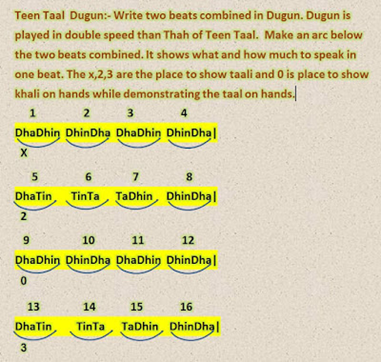
Exceptional skill is required on the part of the percussionist as well as the melodic soloist to keep track of measurements and sub-divisions pertaining to any tala.Talas are learnt orally by memorizing Indian sounding mnemonics. First you must learn to speak the sounds, internalize it and then play it on your tabla or mridangam or percussion instrument. It eventually becomes the instinct of professional musicians.
Talas also have vocalized equivalents where beats can be represented phonetically. Percussionists will often recite these phrases and then perform them on the tabla or mridangam. This is known as bol in North Indian music and Solkattu in Carnatic music.
Around the sixteenth century as a result of Islamic influence and Muslim rule in North India, Indian Classical music separated into North Indian music and South Indian music. Raag and tala continued to remain at the centre of both traditions, however, the same raags and musical concepts like tala are known by entirely different names. However, the basics of the tala system have remained the same in both North Indian and Carnatic music and are detailed below-
- The no. of beats to be performed in a cycle or set are repeated in a piece in both North Indian and Carnatic music
- The first beat of the tala is known as the sama. It is the most important point of rhythmic emphasis in a tala and all variation in a tala eventually return to the sama. The sama is recognized as the part where there is a bit more force/emphasis. The raaga does not have to necessarily begin from the sama.
- Both the systems of music use various symbols to depict ‘angas’ or the sub-section or bar division of the tala.
- Both follow 3 speeds, and both finish a rhythmic pattern with a 3 pattern rhythmic end
- Beats in both systems are shown by movement of fingers, hand claps, hand waves).
In the North, the main instrument used for tala is tabla. In the Carnatic system the main instrument is the mridangam (elongated barrel shaped drum) and kanjira (frame drum). As mentioned above, cymbals are also used for tala.

Image of Tabla – used to keep Tala in North Indian classical music
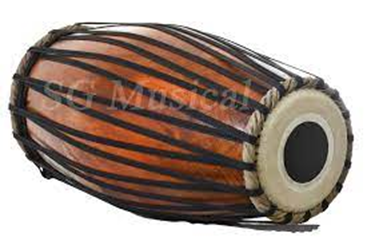
Mridangam – used to keep Tala in Carnatic music
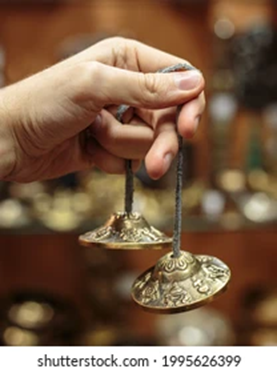
Tala cymbals
